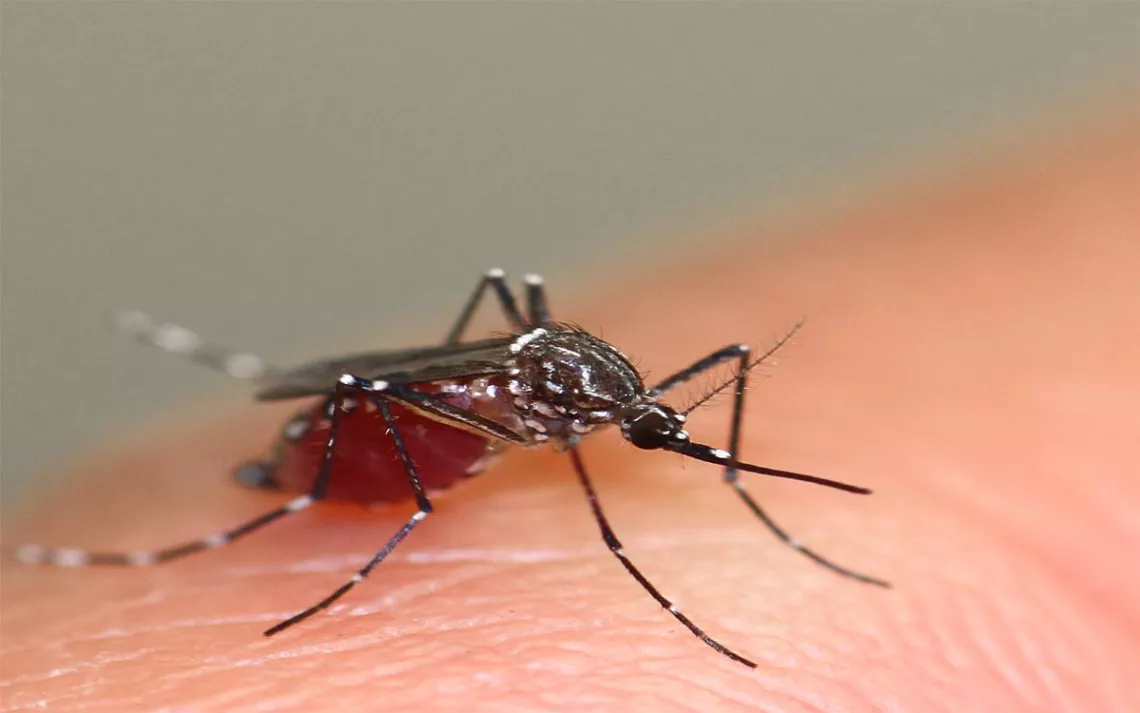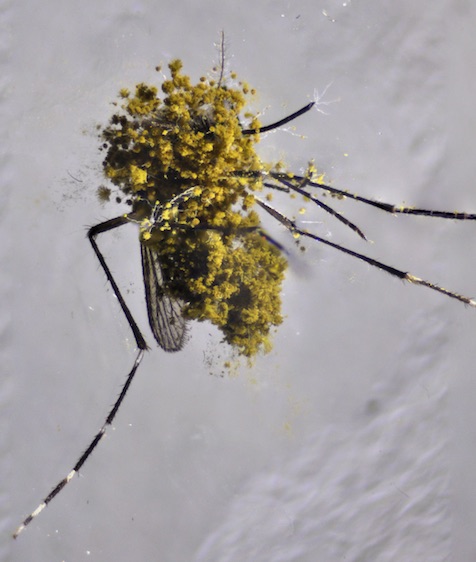Scientists Race to Kill Mosquitoes Before They Kill Us
Three-fourths of the U.S. is now at risk for Zika, West Nile, and other tropical diseases

A female Aedes aegypti mosquito following a blood meal. This mosquito is the main vector of dengue, Zika, and chikungunya viruses. | Photos courtesy of Jose L. Ramirez-USDA
Since West Nile virus made its debut in New York City over a decade ago, outbreaks of mosquito-borne diseases, especially West Nile virus, have become increasingly commonplace. As temperatures reach new highs as a result of global climate change, mosquitoes that once called the tropics home find the United States just as habitable. A recent report from the Centers for Disease Control and Prevention found that Aedes aegypti—which is capable of transmitting the Zika, dengue, and chikungunya viruses—could find suitable breeding habitats in 75 percent of the contiguous United States.
Efforts to deal with the unwelcome vectors, however, are already running into trouble. In a poorly executed plan to suppress mosquitoes in South Carolina last year, officials in Dorchester County misted an insecticide called Naled—deadly to both honeybees and mosquitoes—through the air over Summerville without warning local beekeepers. The subsequent deaths of millions of bees served as a wake-up call that weapons beyond pesticides are needed to fight the spread of mosquito-borne diseases.
According to Jose Luis Ramirez, an entomologist with the USDA’s Agricultural Research Service in Peoria, Illinois, many pesticides can not only cause adverse reactions in animals and humans, but they also become ineffective over time. “It’s an arms race,” he says. “At the same time we’re trying to kill them, mosquitoes are evolving to evade death and developing resistance to pesticides.”
 In order to prevent mosquitoes from developing resistance, Ramirez and his team of scientists are developing bio-pesticides made from fungi that kill mosquitoes but do not impact other insects or humans. The fungi are entomopathogenic—that is, they act like parasites—and are particularly effective at killing mosquitoes.
In order to prevent mosquitoes from developing resistance, Ramirez and his team of scientists are developing bio-pesticides made from fungi that kill mosquitoes but do not impact other insects or humans. The fungi are entomopathogenic—that is, they act like parasites—and are particularly effective at killing mosquitoes.
The magic of the fungi is in their ability to morph. When fungal spores land on a mosquito, they awaken from a resting phase and burrow into the insect. Once inside, the fungus changes into a blastopore, a simpler structure that lacks molecules that could alert the insect’s immune system. This allows them to multiply in great numbers, eventually killing the mosquito. Soon after the insect is dead, the fungal blastopores continue to grow and re-emerge from the corpse as threadlike filaments called hyphae.
“We’re trying to pinpoint the best fungal candidates and the compounds found in the fungi that allow the fungi to kill or evade the mosquito’s immune system,” Ramirez says. If his team can pinpoint such compounds, they could be extracted from the spores and made into targeted bio-pesticides designed to kill mosquitoes without harming anything else.
ARS entomologist Ephantus Juma Muturi is working on another possible approach—identifying a chemical in blackberry leaves that both attracts and kills mosquito larvae. Muturi says that mosquitoes of the genus Culex, which also transmit West Nile, like to lay their eggs in water laden with bacteria that the larvae can consume. But when blackberry leaves are put into water, mosquitoes will lay their eggs there even when the environment isn’t good for offspring survival. Field tests are still in the future, he says. “First, we need to isolate and identify the chemical(s) that attract egg-laying mosquitoes to blackberry infusions and those that are toxic to mosquito larvae. We’re not sure whether it’s a toxic chemical that blackberry leaves produce that kills the larvae or whether a blackberry infusion lacks enough bacteria for the larvae to survive.”
Scientists from the biotech company Oxitec are working on a more controversial approach. They have genetically modified mosquitoes to produce a protein that kills them in the absence of the antibiotic tetracycline, which they are given in the lab to survive. Once released, however, the mosquitoes die, but not before passing this trait on to their offspring. Field trials in other countries such as Brazil have reported an 86-to-90 percent decrease in the number of mosquitoes after the introduction of this modified variety. U.S. field tests were to have taken place in Key Haven, Florida, but residents fought hard to oppose it, concerned about unforeseen repercussions from the genetically modified insects.
The issue is complex, and scientists need to carefully weigh the risk of disease with that of GMO mosquitoes, according to Stephen Mahoney, conservation chair of the Sierra Club Miami Chapter. “The Sierra Club recognizes that action is needed now using the best available techniques that are reasonably safe for the environment, which, at the moment, appear to include the use of genetically modified sterile mosquitoes in Zika-infected areas of Florida,” Mahoney said in a statement.
Last year, the EPA also approved the use of mosquitoes that are not genetically modified but are infected with the Wolbachia pipientis bacterium in the lab. The males are then separated from the females and released into the wild. The males then mate with wild female Aedes albopictus mosquitoes, which can transmit a number of tropical diseases. The resulting fertilized eggs fail to hatch.
Whatever the method, the race is on to blunt this potentially deadly aspect of climate change. “We need as many tools as possible to be successful at stopping the spread of mosquito-borne disease,” Ramirez says.
 The Magazine of The Sierra Club
The Magazine of The Sierra Club



